
History of Pirate Surgeons Menu: 1 2 3 4 5 6 7 8 9 10 11 12 Next>>
The History of Sea and Pirate Surgeons, Page 1
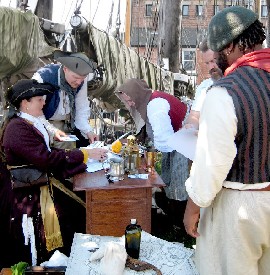
Photo: Mission - Pirates signing the articles
"…[Peter Scudamore] had signed the pirates' Articles with a great deal of alacrity, and gloried in having been the first surgeon that had done so (for before this it was their custom to change their surgeons when they desire it, after having served a time, and never obliged them to sign, but he was resolved to break through this for the good of those who were to follow), swearing immediately upon it, he was now, he hoped, as great a rogue as any of them." (Charles Johnson, The General History of the Most Notorious Pirates, 3rd Edition, p. 308-9)
As Captain Johnson suggests, Peter Scudamore was unusual in that he willingly joined Bartholomew Robert's group of pirates when he was taken out of the Mercy in 1721. Signing the articles was the equivalent of signing your death warrant if the pirates were caught.
Surgeons on pirate ships were in a precarious position, caught between the threat posed by the pirates for not doctoring them well and the threat posed by the Navy should the pirates be captured and the surgeon be accused of being one of them. They were also interesting characters in and of themselves, so let's take a closer look at the pirate surgeon's role in history.
Pirates and Sea-surgeons in Ancient History
To understand the sea-surgeon in history, we must begin by looking at the places where he would be most needed. The sailors who primarily required medical assistance in any time period were those who intentionally put themselves in harm's way.
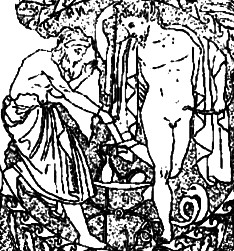
Detail from an Etruscan Mirror
Machaon healing Philoctetes' foot
Warfare and sea-traveling armies would be the most likely places to find a need for the first sea-surgeons. The nature of warfare and the need to keep men in battle as long as possible lend themselves readily to a practiced and efficient medical hand on site.
Little written evidence exists from the BC period of history, so finding evidence of sea-surgeons, let alone pirate surgeons, is difficult at best. In book four of Homer's epic the Iliad, he describes the need for a physician to treat Menelaus after he is wounded in the abdomen by Pandarus's arrow. Although Menelaus protests that it is merely a flesh wound, King Agamemnon sends for the surgeon Machaon explaining that "...the surgeon shall examine your wound and lay herbs upon it to relieve your pain."1 Machaon did so after "he wiped away the blood"2 allowing Menelaus to fight another day.3
As diverting as Greek Mythology is, it does not tell us much about the surgeon at sea. Perhaps a more interesting (and historically factual) source of information are the carvings from the mortuary temple of Ramesses III in Luxor, Egypt. Some of these hieroglyphs show a group, widely identified today as 'the Sea Peoples,' attacking from the water around 1180 BC. The images show some of the Sea People's soldiers clinging to ship's masts and bodies drifting in the waves.
While none of these images show the Sea Peoples being repaired by sea-surgeons, one

Source: Temple of Medinet Habu, Thebes - Battle of the Delta Between Ramesses III and the Sea Peoples
author tells us that "they were tribes who had developed a life style almost totally dependent upon the sea. They perfected boats, sailing and navigational techniques for fishing offshore as well as long distance travel and explored much of the Atlantic ocean."4 Such a gregarious, traveling people may easily have found a need for surgeons on the water, especially when going to war. (Since they were regarded by some as pirates this suggests they may have been the first pirate surgeons. Although I am really stretching this premise now.)
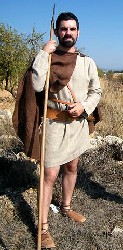
In another bit of possible indirect support of the idea of pirate surgeons in early history, we find pirates turning mercenary to hire themselves out to fight for various ancient city-states. In his book Piracy in the Ancient World, Henry Ormerod explains that pirates "formed a part of the crews in the fleet with which Demetrius [of Macedonia] attacked Rhodes in 305-304 B.C., and pirate vessels were used to ravage the coasts of the island. Piracy along the Mediterranean flourished off and on during this period in history."
Ormerod also tells of an arch-pirate in his service, by name Timocles, who was captured off the Peraea by the Rhodians. The crew of his three undecked vessels were considered the best in the service of Demetrius."5 This shows that the pirates were part of a military force that would have been the most likely place to find surgeons amongst a crew.
1Homer, The Iliad, Book IV, translated by Samuel Butler, http://www.greekmythology.com/Books/Iliad/I_Book_IV/i_book_iv.html, gathered 6/17/12; 2Ibid; 3Homer, The Iliad, Book V; 4The Sea Peoples, http://www.faculty.ucr.edu/~legneref/bronze/seapeopl.htm, gathered 6/17/12; 5Henry A. Ormerod, Piracy in the Ancient World, p. 122-3
Pirates and Sea-surgeons in Ancient Rome
We later find the Cilicians razing the Mediterranean. These are the pirates who are credited with
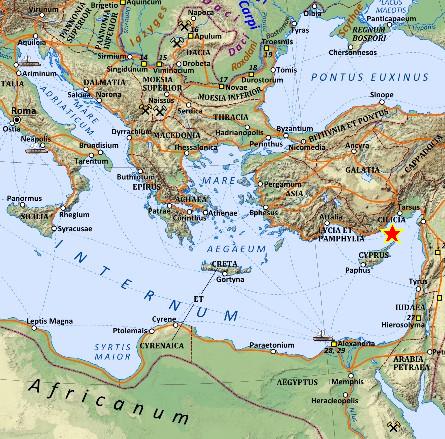
capturing Julius Caesar when he was young. They were planning to ask twenty talents for Caesar, but he recommended that fifty would be more appropriate. Johnson tells us, "they were both pleased, and surpriz'd at his Answer"1 and went ahead with the revised amount. They were probably less 'pleased and surpriz'd' when, after he was released, Caesar caught them and had them executed.
The Cilicians were actually a highly organized group. Henry Ormerod tells us that in the first century BC, "[t]heir elaborate organization… had by this time been brought to a high state of perfection. The miseries entailed by the constant wars in which Rome was engaged had added greatly to their numbers, which are given as many tens of thousands."2 With such a group of pirates forming a militaristic unit, one can't help but wonder how many surgeons worked among them.
The pirates gradually spread out their area of operation, requiring medical care in distant ports. Ormerod says, "Although Cilicia still remained their headquarters, pirates by this time swarmed on all the coasts of the Mediterranean, possessing everywhere fortified bases and watch-towers, and carrying out their raids on all sides."3 Again, even without proof of surgeons going with the sailors to sea, one has to wonder how else they would have found medical care in these distant land-bases.
One of the first places we find actual evidence of a sea-surgeon at work is on the other side of the battle:
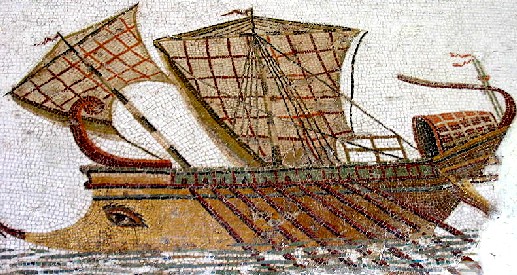
A Tunesian
Mosaic of a Roman Trireme
in ancient Rome. Zachary Friedenburg tells us that "practitioners of medicine and surgery were assigned to each trireme [a Roman warship], one for each two hundred men."4 In a letter sent by the Roman soldier Apion to his father Epimachus, he comes tantalizingly close to giving us more direct proof of the existence of the sea-surgeon, but stops short when he says, "I thank the Lord Serapis [a Greek god] that when I was in danger at sea he straightway saved me."5 Some have interpreted the original Greek this to mean that Apion was saved by Serapis through the assistance of a sea-surgeon. Whether this is so is something best left to Greek scholars. Suffice it to say that the Romans give us the first direct evidence we can point to of sea-surgeons in the ancient world.
1Captain Charles Johnson, The general history of the pyrates, p. 19; 2Henry A. Ormerod, Piracy in the Ancient World, p. 221; 3Ibid; 4Zachary Friedenberg, Medicine in the Age of Sail, p. 1; 5Milligan, Selections from Greek Papyri, p. 90-1

